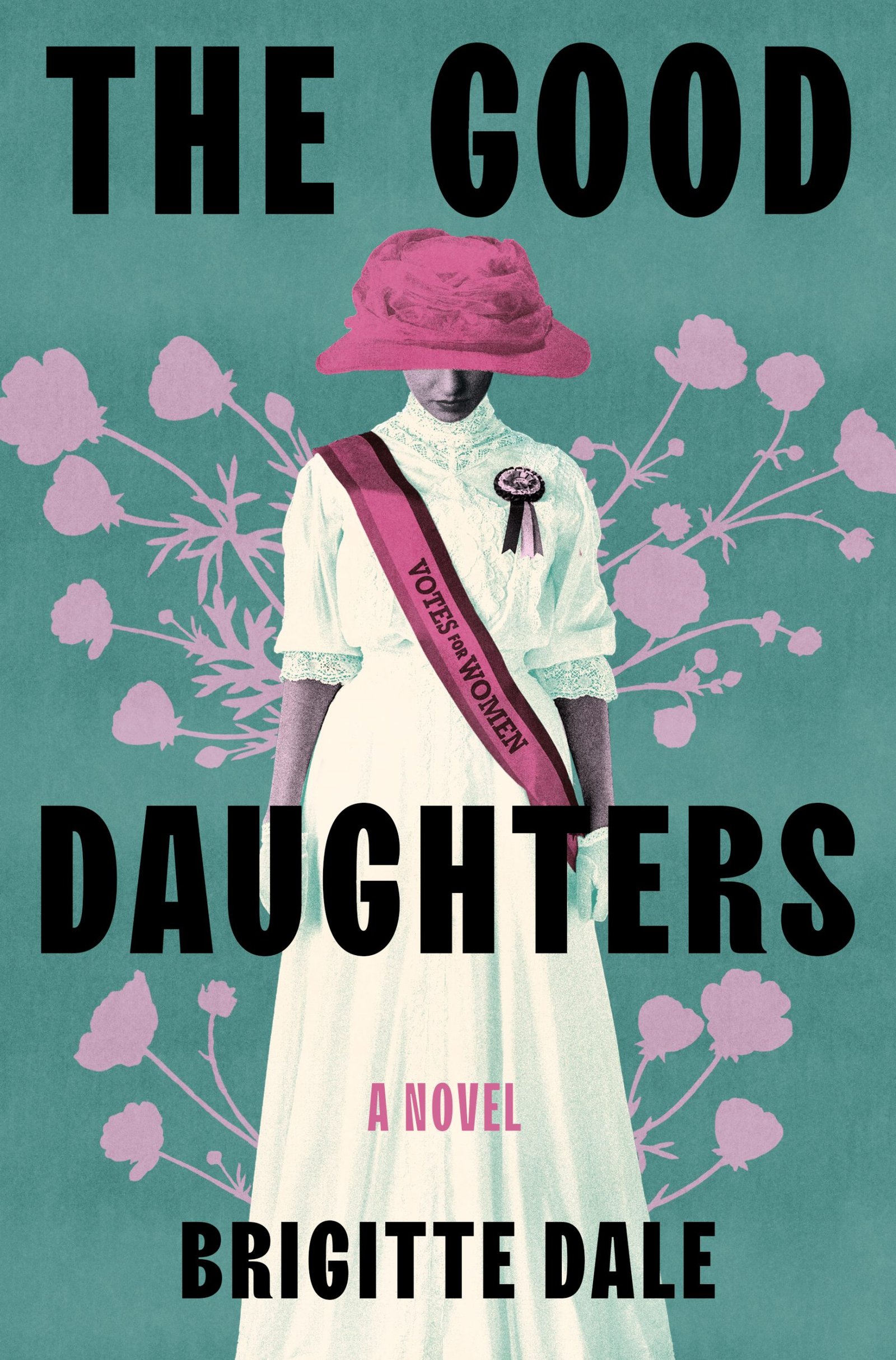WRITTEN BY MYFANWY COOK
Debut novelists Brigitte Dale, Martha Jean Johnson, Sarah Landenwich, and Emma Pei Yin introduce readers to mysterious and intriguing characters and moments in history.

Dale explains: “In a crammed AP curriculum that focused almost exclusively on male figures in European history, Pankhurst was one of the few non-royal, regular women I had the chance to learn about. I soon discovered, though, that she was anything but ordinary. A woman who led marches of 250,000 suffragettes through London! Who traveled the world and went to jail and put her life on the line for the right to vote!
“I was so excited to present my research on Pankhurst to my classmates, until a blizzard blew in and school was cancelled. When we returned, the research projects were abandoned; we were racing to finish the AP curriculum, and unfortunately, Emmeline Pankhurst and the suffragettes were among the many women and people of color deemed not a priority by the test-makers. I never got to tell my classmates all I’d learned, and I felt the injustice of this erasure.”
It was a few years later, she says, that “my college class on women’s history reintroduced me to Pankhurst and her Women’s Social and Political Union. By then, I was fascinated with the suffragettes whose motto, ‘Deeds Not Words,’ exemplified their commitment to breaching the traditional bounds of Victorian propriety in order to make their bodies the site of their activism, engaging in public marches, protests, prison sentences, and hunger strikes in their efforts to win the right to vote.”
Dale was in graduate school when she first considered transforming her historical research into fiction. “In prison, women often endured terrible conditions, lacking the rights of political prisoners, and suffering hunger strikes and forced feedings. I found it compelling that there were women on both sides of the bars—not just the incarcerated suffragettes, but also the women working in the notorious Holloway Prison. I realized I wanted to tell the story of both those groups of women, and how their lives would intersect. This felt like my chance, finally, to tell the suffragettes’ story to a wider audience.”
As Dale points out, “There was significant stigma associated with the word ‘suffragette,’ which was originally an insult to belittle women activists, though later reclaimed as a term of pride. I wanted to explore the lives of women from all different backgrounds for whom associating with the suffragette campaign represented a great risk and also, ultimately, meaningful freedom and empowerment. My characters are aristocrats and working class, ex-pats and students. They represent the real diversity of the movement, and the different kinds of sacrifices these women had to make.”
The academic research she carried out helped her to populate the world of 1910s London with accuracy. “But ultimately, writing this as fiction helped me understand the suffragettes on an emotional level. Their story is not just political—and more relevant than ever—but it’s about friendship, chosen family, and incredible perseverance. Women’s stories should never be relegated to the footnotes of history, and I’m gratified that through fiction, I am able to shine a light on the story of the suffragettes.”
 The idea for Sarah Landenwich’s The Fire Concerto (Union Square, 2025) started several years ago. “I had the idea to write a story about three female pianists—one in the 19th century, one in the early 20th, and one in modern times—connected by their pedagogical lineage. I have a background in classical piano. This idea of ‘musical ancestry,’ tracing the line of teachers from which you descend, was familiar to me from the musical world, but I had never seen it explored in literature.”
The idea for Sarah Landenwich’s The Fire Concerto (Union Square, 2025) started several years ago. “I had the idea to write a story about three female pianists—one in the 19th century, one in the early 20th, and one in modern times—connected by their pedagogical lineage. I have a background in classical piano. This idea of ‘musical ancestry,’ tracing the line of teachers from which you descend, was familiar to me from the musical world, but I had never seen it explored in literature.”
At its first conception, Landenwich “thought the novel would be a braided narrative,” she relates. However, she “quickly realized that a book with three different time periods and three separate stories would be too long to ever get published. So, I started searching for a different way to tell the story. One of my favorite books is A. S. Byatt’s masterful novel Possession.” She studied Byatt’s structure—the scholars in the present investigating a thrilling mystery of the past through texts and historic artifacts and thought she would write the Possession of classical music.
“I began working on The Fire Concerto in earnest at a time of incredible personal upheaval. I had just become a mother and had also developed some concerning neurological symptoms that led to a difficult year of doctor’s visits and an anxious search for a diagnosis. Holding the desperate love I had for my baby alongside the fear that there may be a future when I couldn’t care for her was heartbreaking. I’m happy to say that I am now completely recovered, but it was an existential time, to say the least. I wrote all of those feelings into the lives of my characters, many of whom suffer from an injury or condition that prevents them from pursuing the life they wish to live.”
For Landenwich there is “an aphorism in writing that you must write the novel only you can write. I don’t know if I necessarily believe in it. But I do think this book is a unique outgrowth of me. I bear no resemblance to the characters or their experiences, but my own passions, interests, heartbreak, and hope are on every page.”
 Like countless others, Martha Jean Johnson, author of The Queen’s Musician (SparkPress, 2025), has been fascinated by Anne Boleyn since she was young. “Henry VIII adored her, and then, incredibly, she ousted the reigning queen. A few years later—after she ‘fails’ to give birth to a son—the king decides to have her killed.” These events, Johnson stresses, “changed history,” but adds, “There’s also a human mystery here. How did the king’s love turn into hate? Was any other ending possible? Historians and Anne Boleyn’s considerable fan base still wrestle with these questions.”
Like countless others, Martha Jean Johnson, author of The Queen’s Musician (SparkPress, 2025), has been fascinated by Anne Boleyn since she was young. “Henry VIII adored her, and then, incredibly, she ousted the reigning queen. A few years later—after she ‘fails’ to give birth to a son—the king decides to have her killed.” These events, Johnson stresses, “changed history,” but adds, “There’s also a human mystery here. How did the king’s love turn into hate? Was any other ending possible? Historians and Anne Boleyn’s considerable fan base still wrestle with these questions.”
The Anne Boleyn story is, for Johnson, “one of kings and queens, dynastic families, international rivalries, and powerful, titled individuals. But at the center of the drama was a young man from a poor family, a popular musician but nothing more.
“Mark Smeaton was one of Henry VIII’s favorite players. Historical records document the gifts and honors he received from the king. Anne Boleyn’s brother gave him a book, and the musician wrote his name in it … Suddenly, he was taken to Thomas Cromwell’s house and accused of being Anne Boleyn’s lover. He confessed—a confession that was almost certainly coerced. Two days before Anne Boleyn’s execution, he was beheaded, probably at the age of twenty-three or twenty-four.”
This handful of facts prompted both Johnson’s curiosity and sympathy, “How did this young musician rise to what must have been the height of success in his day? What was he like? How did he become entangled in Henry VIII’s machinations? What is it like to be falsely accused and have no means to defend yourself? What is it like to lose all you have worked for in the space of a single night and day?”
Johnson feels that “compared to others in this saga, Mark Smeaton seems more like most of us.” She explains: “He’s the commoner, the employee, the one who tried to better himself. He wasn’t powerful. No one addressed him as ‘sir’ or ‘my lord’. He was only talented. I wanted to imagine and tell his story.”
 When Sleeping Women Wake (Ballantine/Quercus, 2025) by Emma Pei Yin, “began the same way a low tide pulls back before a storm,” says the author. “It started with my grandfather’s voice, matter-of-fact and unadorned, recounting his childhood during the Japanese occupation of Hong Kong. I was a child myself then, sitting beside him in the courtyard of our ancestral home in Tai Wo, half-listening as he spoke of soldiers and scarcity, of hunger and hiding, of neighbours who disappeared. I listened, not because I understood, but because I loved him. It wasn’t until much later that I realised the grief braided into his stories.
When Sleeping Women Wake (Ballantine/Quercus, 2025) by Emma Pei Yin, “began the same way a low tide pulls back before a storm,” says the author. “It started with my grandfather’s voice, matter-of-fact and unadorned, recounting his childhood during the Japanese occupation of Hong Kong. I was a child myself then, sitting beside him in the courtyard of our ancestral home in Tai Wo, half-listening as he spoke of soldiers and scarcity, of hunger and hiding, of neighbours who disappeared. I listened, not because I understood, but because I loved him. It wasn’t until much later that I realised the grief braided into his stories.
“I lived in Hong Kong during high school, and I moved through the city like it was any other modern place—past the pillboxes hidden across the New Territories, past military tunnels half-swallowed by banyan roots. I rode buses through Wanchai, not knowing the same roads once rumbled with army convoys. I walked through Kowloon and Central, past colonial buildings that had once held prisoners. These places, that were folded into daily life, were so ordinary to me then, unremarkable almost.”
But when Yin began writing this novel, “the past came to life. Every street corner became charged with historical memory, and I saw it all differently. I saw what had been endured.
“My grandfather is Hakka and always spoke with pride about the East River Column, where many resistance fighters emerged from villages like ours. But it was the silence of my grandmother that stayed with me. She was a baby during the war, too young to remember, yet she lived in its long shadow. She never told stories, and I began to wonder what her silence held.” It was at that point that, for Yin, “that wondering became a novel.”
When Sleeping Women Wake is Yin’s “attempt to give voice to those who endured quietly,” she says, “especially women whose histories were rarely recorded. I wanted to honour their survival—not through spectacle, but through care, through persistence, through love held amidst fear. Writing this book was not just an act of imagination. It was a homecoming. And a long overdue listening and acknowledging of family stories.”
About the contributor: Myfanwy Cook is an Associate University Fellow. She creates HF writing workshops and is currently engaged in highlighting the 200th anniversary of passenger rail transport in the UK. Contact (myfanwyc@btinternet.com) if you uncover debut novelists you would like to see showcased.
Published in Historical Novels Review | Issue 113 (August 2025)


